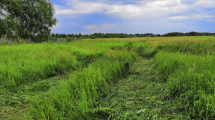Abstract
The mites Sphexicozela connivens infesting the larvae of the future foundresses of Polistes nimpha have been shown to affect their size and the melanin pattern of some body parts. Foundresses reared in the infested environment have shorter wings and paler variants of metasomal sternite IV. The role of such morphotypes in the formation of Polistes nimpha population is discussed.
Similar content being viewed by others
References
Cervo, R., Dapporto, L., Beani, L., et al., “On Status Badges and Quality Signals in the Paper Wasp Polistes dominulus: Body Size, Facial Color Patterns and Hierarchical Rank,” Proc. R. Soc. B 275, 1189–1196 (2008).
Dlussky, G.M., Fedoseeva, E.B., and Thompson, L.Ch., “Variability in the Ants Solenopsis richteri and S. wagneri (Hymenoptera, Formicidae): Statistical Analysis of Morphologic Characters,” Uspekhi Sovr. Biol. 118(3), 283–298 (1998).
Glants, S., Medical and Biological Statistics (Praktika, Moscow, 1999) [in Russian].
Lloyd, M., “Mean Crowding,” J. Anim. Ecol. 36, 1–30 (1967).
Mahunka, S., “Sphexicozela connivens gen. n., sp. n. (Acari, Acaridoidea); a New Mite from Wasp Nest,” Parasitol. Hungarica 3, 77–86 (1970).
Makino, S., “Biology of Latibulus argiolus (Hymenoptera: Ichneumonidae), a Parasitoid of the Paper Wasp Polistes biglumis (Hymenoptera: Vespidae),” Kontyû 51(3), 426–434 (1983).
O’Connor, B.M., “Cohort Astigmatina,” in A Manual of Acarology. Third Edition, Ed. by G.W. Krantz and D.E. Walter (Texas Techn. Univ. Press, Lubbock, 2009), pp. 565–658.
Perfilieva, K.S., “Wing Venation Anomalies in Sexual Individuals of Ants (Hymenoptera, Formicidae) with Different Strategies of Mating Behavior,” Zool. Zh. 79(11), 1305–1312 (2000) [Entomol. Review 80 (9), 1181–1188 (2000)].
Rusina, L.Yu., Polistine Wasps in Natural and Anthropogenic Landscapes of the Lower Dnieper Basin (Kherson. Gos. Univ., Kherson, 2006) [in Russian].
Rusina, L.Yu., “Structural and Functional Organization of Paper Wasp Populations (Hymenoptera: Vespidae),” Trudy Russk. Entomol. Obshch. 78, 1–217 (2009).
Rusina, L.Yu., Bogutskii, M.P., Gilev, A.V., and Orlova, E.S., “The Phenotypic Structure of Settlements of Polistes nimpha (Christ) (Hymenoptera: Vespidae) in Lugansk Nature Reserve,” Izv. Kharkov. Entomol. Obshch. 15(1–2), 121–130 (2008a).
Rusina, L.Yu., Gilev, A.V., Firman, L.A., et al., “Coloration Variation of the Paper Wasp Polistes nimphus (Christ) (Hymenoptera, Vespidae) in Ukraine and the South Transural Region of Russia,” Prirod. Almanakh Biol. Nauki, No. 10, 158–173 (2008b).
Rusina, L.Yu. and Orlova, K.S., “Relation between Phenotypic Variability of Females of the Wasp Polistes dominula and the Feeding Regime of Their Larvae,” Trudy Russ. Entomol. Obshch. 81(2), 165–171 (2010).
Rusina, L.Yu., Orlova, K.S., and Govorun, A.V., “The Phenotypic Structure of the Population of Polistes nim pha (Christ) (Hymenoptera: Vespidae) in Vakalovshchina Tract, Sumy Province,” Prirod. Almanakh Biol. Nauki, No. 14, 151–161 (2010).
Strambi, C., Strambi, A., and Augier, R., “Protein Level in the Haemolymph of the Wasp Polistes gallicus L. at the Beginning of Imaginal Life and during Overwintering. Action of the Strepsiterian [sic] Parasite Xenox vesparum Rossi,” Experientia 38, 1189–1190 (1982).
Sullivan, J.D. and Strassmann, J.E., “Physical Variability among Nest Foundresses in the Polygynous Social Wasp, Polistes annularis,” Behav. Ecol. Sociobiol. 15, 249–256 (1984).
Tibbetts, E.A. and Curtis, T., “Rearing Conditions Influence Quality Signals but not Individual Identity Signals in Polistes Wasps,” Behav. Ecol. 18, 602–607 (2007).
Turillazzi, S., “Seasonal Variation in the Size and Anatomy of Polistes gallicus (L.) (Hymenoptera, Vespidae),” Monit. Zool. Ital. N. S. 14, 63–75 (1980).
Zhivotovskii, L.A., Population Biometrics (Nauka, Moscow, 1991) [in Russian].
Author information
Authors and Affiliations
Additional information
Original Russian Text © L.Yu. Rusina, E.S. Orlova, 2011, published in Entomologicheskoe Obozrenie, 2011, Vol. 90, No. 2, pp. 241–248.
Rights and permissions
About this article
Cite this article
Rusina, L.Y., Orlova, E.S. The relationship between phenotypic variability in future foundresses of Polistes nimpha (Christ) (Hymenoptera, Vespidae, Polistinae) and infestation of their larvae by the mite Sphexicozela connivens Mahunka (Acari, Astigmata, Winterschmidtiidae). Entmol. Rev. 91, 685–691 (2011). https://doi.org/10.1134/S0013873811060017
Received:
Published:
Issue Date:
DOI: https://doi.org/10.1134/S0013873811060017




